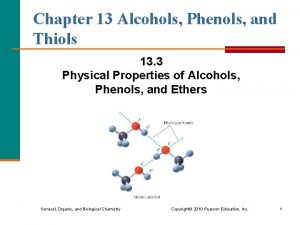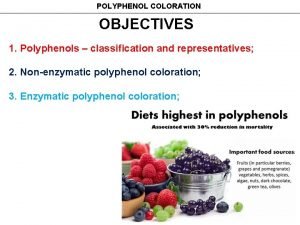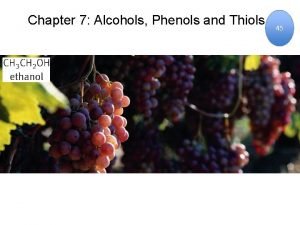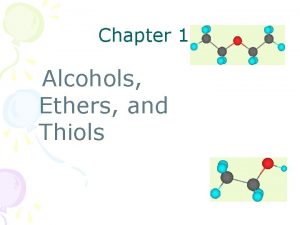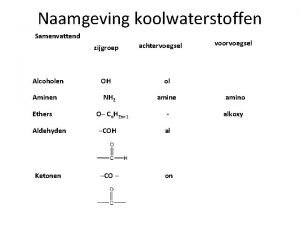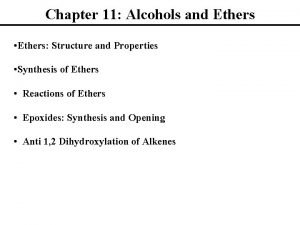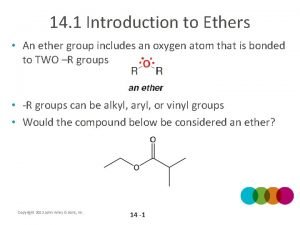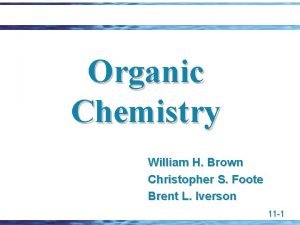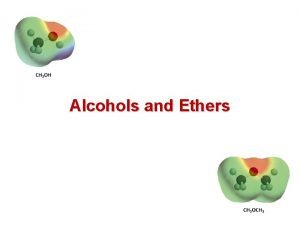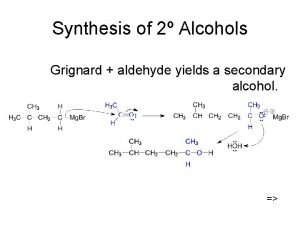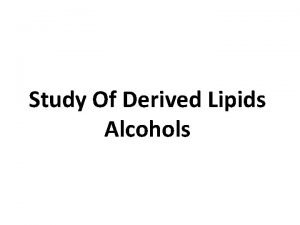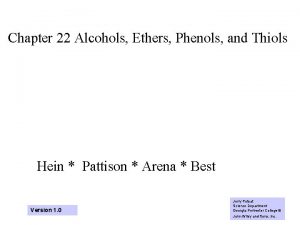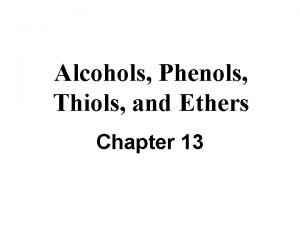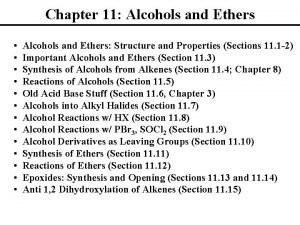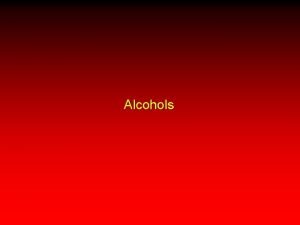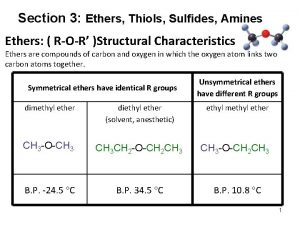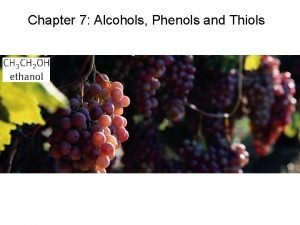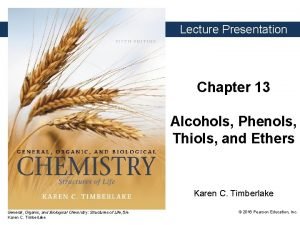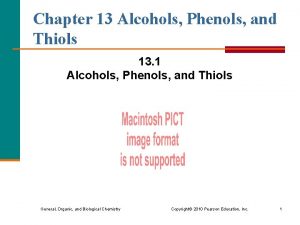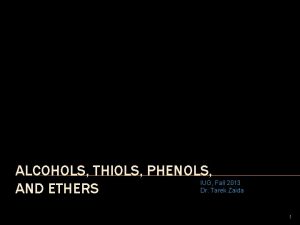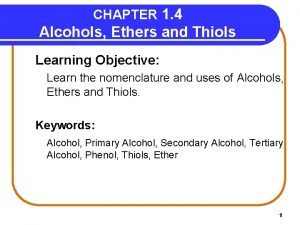Alcohols Phenols Thiols and Ethers Dr Michael P



















- Slides: 19

Alcohols, Phenols, Thiols, and Ethers Dr. Michael P. Gillespie

Introduction • The characteristic functional group of alcohols and phenols is the hydroxyl group (-OH). • Alcohols have the general structure R-OH, in which R is any alkyl group. • Phenols have the general structure R-OH, in which R is an aryl group. • They are substituted water molecules in which one of the hydrogen atoms has been replaced by either an alkyl group or an aryl group.

Introduction • Ethers have two alkyl or aryl groups attached to the oxygen atom. • Thiols contain the sulfhydryl group (-SH). • Many important biological molecules, including carbohydrates, lipids, and proteins, contain hydroxyl and/or thiol groups.

Alcohols: Structure & Properties • Alcohols are characterized by the hydroxyl group (-OH). • They have the general formula R-OH. • The hydroxyl group is polar; therefore, alcohols are polar and form hydrogen bonds. This gives them higher boiling points. • Smaller alcohols are very water soluble.

Alcohols

Medically Important Alcohols • Methanol is a toxic alcohol that is used as a solvent. • Ethanol is the alcohol consumed in beer, wine, and distilled liquors. • Isopropanol is used as a disinfectant. • Ethylene glycol is used as antifreeze. • Glycerol is used in cosmetics and pharmaceuticals.

Classification of Alcohols • Alcohols can be classified as primary, secondary, or tertiary depending upon the number of alkyl groups attached to the carbinol carbon (the carbon bearing the hydroxyl group).

Preparation of Alcohols • Alcohols can be prepared by the hydration of alkenes or the reduction of aldehydes and ketones.

Dehydration of Alcohols • Dehydration of alcohols produces alkenes.

Dehydration of Alcohols

Oxidation Reactions • Primary alcohols undergo oxidation reactions to produce aldehydes. • Secondary alcohols undergo oxidation reactions to produce ketones. • Tertiary alcohols do not undergo oxidation.

Oxidation of Alcohols

Oxidation & Reduction in Living Systems • In organic and biological systems, oxidation involves the gain or loss of hydrogen. • Reduction involves the loss of oxygen or gain of hydrogen. • Nicotinamide adenine dinucleotide, NAD+, is a coenzyme involved in many biological oxidation and reduction reactions.

Phenols • Phenols are compounds in which the hydroxyl group is attached to a benzene ring. • The have the general formula Ar-OH. • Many phenols are important as antiseptics and disinfectants.

Phenol

Ethers • Ethers are characterized by the R-O-R functional group. • They are generally non-reactive, but are extremely flammable. • Diethyl ether was the first general antiseptic used in medicine. It has been replaced by Penthrane and Enthrane, which are less flammable.

Ether

Thiols • Thiols are characterized by the sulfhydryl group (-SH). • The amino acid cycteine is a thiol that is extremely important for maintaining the correct shapes of proteins. • Coenzyme A is a thiol that serves as a carrier of acetyl groups in biochemical reactions.

Thiols
 Alcohols phenols thiols and ethers
Alcohols phenols thiols and ethers Ester naming
Ester naming Simple phenols
Simple phenols Nomenclature of ether
Nomenclature of ether Upac name
Upac name Acidity of thiols
Acidity of thiols Ioc revelation thiols
Ioc revelation thiols Alkylalkanoaat
Alkylalkanoaat Ether cleavage
Ether cleavage Naming ethers
Naming ethers Preparation of ethers
Preparation of ethers Ethers boiling point
Ethers boiling point David klein organic chemistry
David klein organic chemistry Acidic cleavage of ethers
Acidic cleavage of ethers Why are ethers relatively inert compounds
Why are ethers relatively inert compounds Acidic cleavage of ethers
Acidic cleavage of ethers Tertiary alcohol oxidation
Tertiary alcohol oxidation Secondary alcohol to aldehyde
Secondary alcohol to aldehyde Alcohols containing cppp nucleus
Alcohols containing cppp nucleus High boiling point alcohols
High boiling point alcohols
